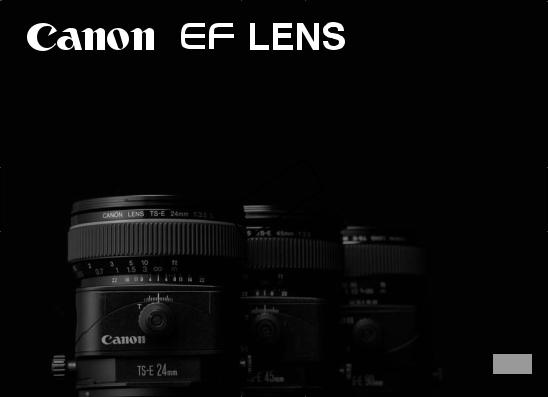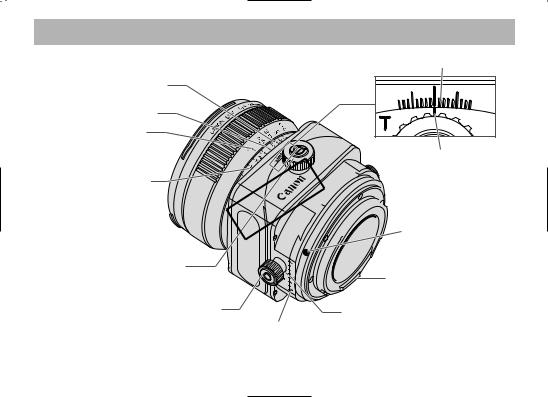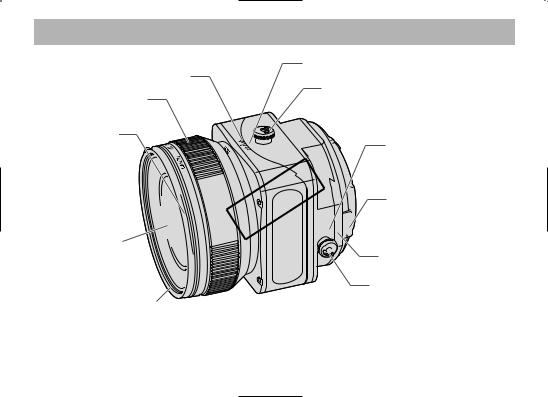Canon TS-E45MM, TS-E90MM, TS-E24MM User Manual

TS-E24mm f/3.5L
TS-E45mm f/2.8
TS-E90mm f/2.8
COPY
ENG
Instructions

Thank you for purchasing a Canon product.
Canon’s TS-E lenses are tilt-shift lenses designed for EOS cameras. The tilt-shift mechanism enables photographers to control the depth of field and the area photographed and to correct image distortion, making it possible to take sophisticated pictures that cannot be shot using a conventional lens.
Features
1.The lens can be tilted up to ±8° and shifted up to ±11mm.
2.The tilt and shift functions can be used singly or in combination.
3.The lens can be rotated to change the tilt or shift direction.
● To ensure that you make the most of the TS-E lens |
|
|
|
|
|
|
|
COPY |
|||||
functionality, it is recommended that you use it with |
Conventions used in this instruction |
|||||
an EOS camera with 100% viewfinder visibility |
|
|
|
|
Warning to prevent lens or camera malfunction |
|
(EOS-1, EOS-1D or EOS-1Ds series) and use the |
|
|
|
|
or damage. |
|
laser matte with grid focusing screen Ec-D and a |
|
|
|
|
|
|
tripod. |
|
|
|
|
|
Supplementary notes on using the lens and |
● On EOS cameras with a built-in flash, some partial |
|
|
|
|
taking pictures. |
|
restrictions may apply to the shift and rotation |
|
|
|
|
|
|
functions.
●On EOS cameras equipped with a grip for vertical shooting, some partial restrictions may apply to the shift and rotation functions.
ENG-1


Nomenclature
Tilt scale (→ 7)
Infrared index (→ 11)
Distance index
Distance scale (→ 5, 11)
Tilt index
Depth-of-Field scale (→ 11)
Tilt knob (→ 7)



 COPY
COPY
Lens mount index (→ 5)
Contacts
Shift knob (→ 9) |
Shift index |
Shift scale (→ 9)
For detailed information, reference page numbers are provided in parentheses (→ **).
ENG-3

Nomenclature
Tilt scale (→ 7) Focusing ring (→ 5)
Hood mount (→ 13)
Lens
Tilt index
Tilt lock knob (→ 7)

 COPY
COPY 
Shift index
Rotation lock release button (→ 10)
Shift scale (→ 9)
Shift lock knob (→ 9)
Filter mounting thread (→ 14)
For detailed information, reference page numbers are provided in parentheses (→ **).
ENG-4

1. Mounting and Detaching the Lens |
2. Focusing |
|||
See your camera’s instructions for details on |
|
|||
mounting and detaching the lens. |
|
|
||
● When mounting or detaching the lens, always |
|
|||
|
ensure that the tilt and shift scales are set to the |
|
||
|
“0” position. |
|
|
|
● After detaching the lens, place the lens with the |
|
|||
|
rear end up to prevent the lens surface and |
|
||
|
contacts from getting scratched. |
|
|
|
● If the contacts get soiled, scratched, or have |
Focus a TS-E lens by turning the focusing ring. |
|||
|
fingerprints on them, corrosion or faulty |
|
||
|
|
(Shots cannot be taken using the auto focus.) |
||
|
|
|
||
|
|
COPY |
||
|
connections can result. The camera and lens |
|
||
|
may not operate properly. |
|
● After using tilt or shift, readjust the focus. |
|
● |
If the contacts get soiled or have fingerprints on |
● The distance scale is only valid when the tilt |
||
|
them, clean them with a soft cloth. |
|
||
|
|
scale is set to the “0” position. |
||
● |
If you remove the lens, cover it with the dust |
|||
|
||||
cap. To attach it properly, align the lens mount index and the index of the dust cap, and turn clockwise. To remove it, reverse the order.
ENG-5
